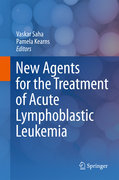
New agents for the treatment of acute lymphoblastic leukemia
Saha, Vaskar
Kearns, Pamela
The majority of cancers present at a relatively advanced stage in which invasion within the primary organ is well established and metastases to lymph and distant organs are either clinically apparent or present at the microscopic level. However, it is increasingly recognized that the natural history of cancer formation is a long and complex path taking many years to develop to a clinically apparent stage in most cases. Furthermore, for most solid tumours there isa pre-invasive or intraepithelial stage of disease. This affords the opportunity for early detection and prevention of invasive disease and hence a cure. However, with this advancing knowledge comes a whole plethora of questions which will be explored in this monograph. Firstly, we need to understand the global burden of pre-invasive disease and what the public health implications mightbe for wide-scale screening programmes. In the western world we already have experience of screening for cervical, breast, prostate and more recently coloncancer. As well as their potential benefits these programmes have financial and psychosocial implications which need to be carefully weighed. This is especially true since many pre-invasive lesions will not progress to cancer in a individual’s lifetime. In addition, there are questions concerning whether screening reduces the cancer burden or in fact distorts the survival figures through lead-time bias. Secondly, at the level of epidemiology and molecular pathogenesis there are important questions regarding the aetiology of pre-invasive lesions; an understanding of which might lead to possible chemopreventive strategies. For example, it would be helpful to know the extent to which the likelihood of developing a pre-invasive lesion is influenced by lifestyle or genetic factors and how these factors influence the risk of progression to invasive disease. At the molecular level we need to understand the pathways and molecularmechanisms, both genetic and epigenetic, by which cells achieve the capacity to invade. Thirdly, in order make clinical progress we need biomarkers to identify and risk stratify individuals with pre-invasive lesions. These biomarkersmight be applied to the serum as in Prostate Specific Antigen in prostate cancer or be applied to tissue samples, such as oestrogen receptor status in breast cancer. In order to utilize biomarkers in the context of a screening programme there are issue around the invasiveness of the test as well as its positive and negative predictive value. With advances in molecular imaging there is now the exciting possibility of incorporating a molecular tag to a non-invasiveimaging modality. Fourthly, in order to justify screening early detection must be coupled to a treatment strategy. If the chemopreventive agent is very well tolerated, then as well as targeting high risk groups, one might consider treatment at the population level. Aspirin is one such drug which has been extensively assessed in the cont Examines the strategies for the use of new agents as well as possible targets of therapy in this disease. Discusses and proposes some solutions to theseissues acute lymphoblastic leukemia. Will be useful to all levels of professionals, students, and researchers. INDICE: The need for new agents. Identifying pre-clinical agents. Pre-clinical evaluation. Design of early phase trials. Strategies for trial design andanalyses. Overview on Molecular and Animal models of ALL. Apoptosis, BCL2. Targeting Stem Cells. Nucleoside Analogues. Flt3 Inhibitors. Tyrosine Kinase Inhibitors. Monoclonal Antibodies. Proteasome inhibitors. Targeting epigenetic pathways in ALL.- Incorporating new therapies in frontline protocols.-.
- ISBN: 978-1-4419-8458-6
- Editorial: Springer New York
- Encuadernacion: Cartoné
- Páginas: 338
- Fecha Publicación: 13/05/2011
- Nº Volúmenes: 1
- Idioma: Inglés
